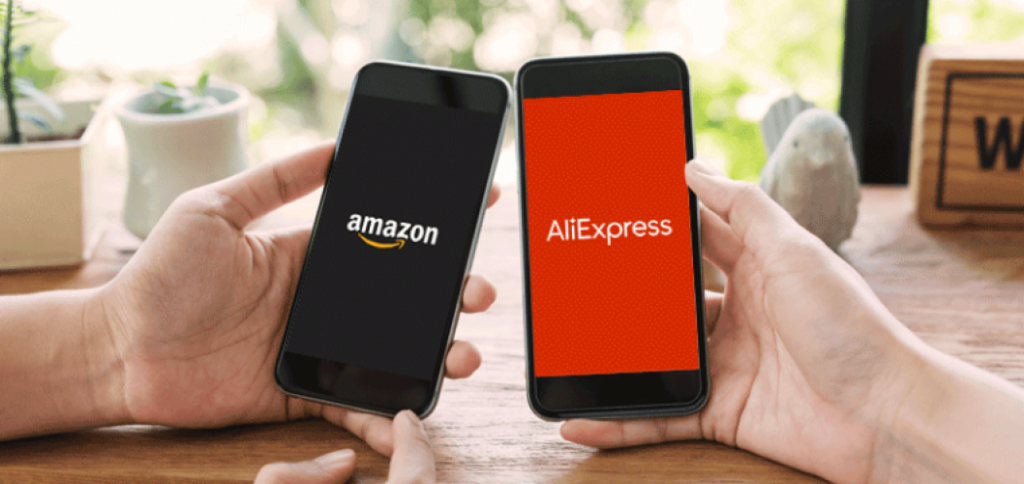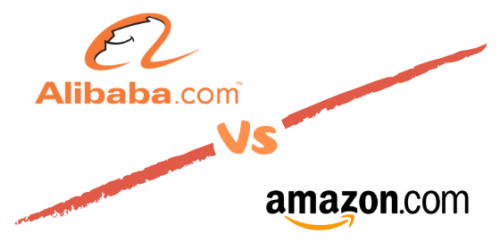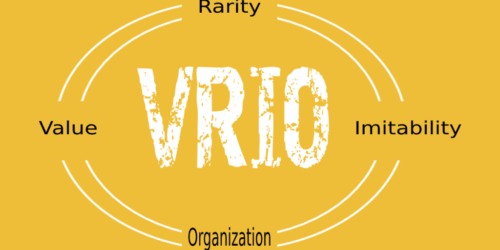VRIO Analysis for Amazon vs. Aliexpress and other competitors

VRIO Analysis for Amazon vs. Aliexpress and other competitors
Introduction
Amazon and Aliexpress are two online retailer platforms that offer a wide array of selection of goods at various prices to their millions of customers. Amazon’s evolution from an online bookseller to the largest e-commerce retailer in the world is remarkable, so does Aliexpress’ growth story from B2B buy-and-sell portal to growing to B2C, C2C, cloud computing, and payment services so far (O’Connell, 2020). Amazon and AliExpress are two long-standing international business rivalries.
This report aims to provide an understanding of whether Amazon has a sustained competitive advantage over its competitors, including Aliexpress, using the VRIO analysis. VRIO is a resource-based framework that focuses on the value, rarity, inimitability and organizational aspects of firms’ resources and capabilities (Peng, 2016). It helps us to analyse the firms’ unique competencies for the purpose of strategic leveraging to create a sustainable competitive advantage (Oregon State University (Ed.), (N.d.)).
In this paper, firstly, I’ve identified the main resources and core competencies Amazon possess, then run each of the resources through the VRIO framework to determine which tangible or intangible resources give Amazon its superior performance. Lastly, I’ve categorized them under “competitive parity”, “temporary competitive advantage”, “unused competitive advantage”, or “sustained competitive advantage” status based on the company’s performance under the value, rarity, inimitability, and organization aspects.
Amazon’s Core Resources and Competencies
Amazon is a company founded in 1994, and it’s developed so many capabilities since then, but its core competencies can be listed as follows (Rancord Society (Ed.), 2019):
- Brand name and reputation
- Customer service
- Customer loyalty
- Distribution network (fulfilment centres)
- Technical expertise
- Brick-and-mortar presence (e.g. Amazon Go, Amazon Books)
- Private label products (e.g. Amazon Basics)
These can be considered the main resources what make Amazon unique and provide competitive advantage to the company against Aliexpress and its other competitors.
VRIO Analysis
VRIO Analysis argues that, for sustained competitive advantage, a firm’s capabilities must create value. Non-value-adding resources can easily turn into weaknesses for the firm and can lead to competitive disadvantage. They also must be rare, because if everybody has it, you can’t make money from it. Resources must be inimitable, and organizationally embedded too. According to the VRIO framework, only valuable, rare, and inimitable resources that are organizationally exploited can create sustainable competitive advantage for the company (Peng, 2016).
I’ll discuss Amazon’s performance for each core capabilities under each of the value, rarity, inimitability, and organizational aspects below.
Value
Value aspect of VRIO analysis seeks answers for questions like: Do firm competencies and resources add value to the market and/or customers (Peng, 2016)?
With a market cap of 1.66 trillion dollars, Amazon is one of the most valuable brands in the world without a dispute (Streitfield, 2020). What makes Amazon unique, and differentiates it from the competitors including Aliexpress, is its brand reputation, customer service quality, and customer loyalty. Amazon customers are loyal to Amazon even more than Apple customers are loyal to Apple (Reisinger, 2020).
Amazon’s tight relationship with its sellers, and tighter relationship with its customers provide the company with a unique value too. It also has great employees with unique skills and capabilities. Amazon’s R&D team try to be constantly innovative, so the company doesn’t fall behind the fierce competition in the e-commerce world, and/or beat by Aliexpress.
The company’s extensive delivery network thanks to its partnerships with third-party service providers, such as courier and delivery companies, allows it to deliver orders in fast as 1 – 2 days, and enhances its value too (Mims, 2018).
Also, Amazon’s private labelling activities, a.k.a AmazonBasics brand, diversify the company’s offerings in a way that Aliexpress has not tap into, yet. AmazonBasics allows the company to compete against other online and offline sellers. Together with its increasing investment in brick-and-mortar stores, private-labelled AmazonBasics products help the company to crack the fashion market (Schaverien, 2018).
With all these, we can say right out of the gate that Amazon’s resources add value to the market and its customers’ lives.
Rarity
Rarity aspect of VRIO analysis seeks answers for questions like: How rare are valuable resources and capabilities? Is it difficult for competitors to acquire such capabilities (Peng, 2016)?
Rarity is important because simply possessing valuable resources is not enough. According to VRIO analysis technique, valuable but common resources and competencies result in competitive parity, at best; however, they don’t create a competitive advantage. Only valuable and rare resources have the potential to provide some temporary competitive advantage (Pratap, 2016).
Amazon.com brand has a high market capitalization and it goes without saying this brand equity is rare in the market among the competitors as much it’s valuable.
Amazon’s growth has been driven by numerous factors and one of them is the customer service quality it offers, and loyalty and trust that the company has successfully built. Not many e-commerce firms have been able to achieve the same, therefore it’s rare.
The company’s proficiency in e-commerce that helps build a competitive advantage is rare too. For sure, other firms may develop their own know-how and expertise but it’s difficult to acquire as much as Amazon’s technical knowhow, especially for the new firms. Aliexpress has developed a great deal of technical and technological proficiency, but it doesn’t change the fact that these 2 giants’ expertise is rare.
Further, Amazon’s warehouses and fulfilment centres are strategic delivery and distribution hubs for the company. The company has more than 110 active fulfilment centres only in the US and more than 185 centres globally (Rattner & Palmer, 2020). When you think it’s an ‘’online’’ retailer company, its extensive investment in warehouses and distribution centres demonstrate Amazon’s commitment to fast fulfilment and delivery and provides a rarity value to the resources too. Amazon strongly beats Aliexpress when it comes to its shipping and delivery times as Aliexpress sellers ship from China, and especially during the pandemic, it takes 35 to 60 days for orders to deliver to the US which is Amazon’s prime, primary market.
When it comes to the company’s brick-and-mortar presence (Amazon Go and Amazon Books) and private label products (e.g. Amazon Basics), although they are valuable to the business as discussed above, they are not rare. Even small businesses implement private labelling nowadays, and brick-and-mortar is not something that runs the company forward. Considering that even the all-time brick-and-mortar giant like Walmart is suffering from the ever-growing store costs and expenses, and trying to enrich its online presence, Amazon’s growing investment in non-online stores might not be its best investment.
Inimitability
Inimitability aspect of VRIO analysis seeks answers for questions like: Can the firm’s resources and core competencies be inimitable? Is it very expensive or too difficult to imitate such resources (Peng, 2016)?
While it is relatively easier to imitate a firm’s tangible resources (e.g. premises), it is a lot more challenging and sometimes even impossible to imitate intangible capabilities (e.g. know-how, expertise, and managerial talents) (Peng, 2016). If it’s hard or expensive to copy a resource or capability, it’s a strength and also a competitive advantage for the company.
I’m of the opinion that only Amazon’s brand name, technical expertise, and delivery network have inimitability value for the company. Even if a competitor creates a website with exactly the same functions, they still cannot beat Amazon because Amazon’s brand reputation is a combination of many factors. When it comes to Amazon’s know-how and delivery network, it’s not impossible to imitate those, but it would be very difficult and also highly expensive for a firm to acquire Amazon’s expertise and also establish such an extensive distribution network like Amazon.
However, in terms of customer service and customer loyalty, it’s not inimitable for a firm to create and maintain high value in those. Maybe not Aliexpress, but for instance another US company called Zappos, an online shoe-seller company, always comes to my mind whenever the customer service topic opens. They were excellent in customer service and had established extraordinary customer loyalty, when Amazon approached to the them and acquired the business in 2009.
Overall, valuable and rare but imitable resources and capabilities may give firms some temporary competitive advantage; however, such an advantage is not likely to be sustainable.
Organized
Organization aspect of VRIO analysis seeks answers for questions like: Is the firm organized to develop and leverage the full potential of its resources and capabilities? Is the organization set up or designed to exploit the resources (Peng, 2016)?
Being organized means, to achieve a competitive advantage, all capabilities of a firm need to complement each other. VRIO framework argues that even valuable, rare, and hard-to-imitate resources and capabilities may not give a firm a sustained competitive advantage if they’re not properly structured and organizationally embedded in the firm’s management, operations, and value proposition.
Amazon maximizes the benefits of its brand reputation by using its brand name in its almost all products such as AmazonGo, AmazonBasics, AmazonBooks, Amazon Prime, etc., and organizing its business around the brand’s fame. The company is aware that Amazon’s brand is what suffices for many customers to buy from Amazon.
Customer service is an area that requires constant quality and continuous innovation. Ecommerce is an intensely competitive field, and Amazon knows that sustaining customer loyalty in this fiercely competitive era is a challenging task. Amazon creates pleasing relationships with its customers even at the cost of upsetting its suppliers (Kim, 2017). There are buyers that abuse this strategy by requesting the return of products that they used, or damaged, and Amazon still accepts returns and refunds although the supplier is not pleased with it. Therefore, although I believe that Amazon’s customer service and loyalty are imitable, I think the company is organized to exploit and realize the full potential of these resources.
Conclusion
As a result of the above analysis and explanations, Amazon’s VRIO framework table is formalized as follows:
| Core Competency | Valuable | Rare | Inimitable (or costly to imitate) | Organized | Implication |
| Brand Name and Reputation | ✔ | ✔ | ✔ | ✔ | Sustained competitive advantage |
| Customer Service | ✔ | ✔ | ✔ | Temporary competitive advantage | |
| Customer Loyalty | ✔ | ✔ | ✔ | Temporary competitive advantage | |
| Distribution network (fulfilment centres) | ✔ | ✔ | ✔ | ✔ | Sustained competitive advantage |
| Technical expertise | ✔ | ✔ | ✔ | ✔ | Sustained competitive advantage |
| Brick-and-mortar presence (Amazon Go and Amazon Books) | ✔ | Competitive Parity | |||
| Private label products (e.g. Amazon Basics) | ✔ | Competitive Parity |
As seen above, I believe Amazon’s brand name, distribution network, and technical expertise are sources of sustained competitive advantage for the company. Aliexpress possess great technical know-how, and their brand is very valuable and sustainable too, but it doesn’t change the fact that, among all competitors, Amazon is doing right what they’re doing when it comes to those resources.
Amazon has only a temporary competitive advantage with its customer service quality they offer, and trust and loyalty they established in customers, as they’re the capabilities that are valuable, rare, and organized, but not inimitable.
When it comes to Amazon’s growing non-online presence, although this capability is valuable and contributes to competitive advantage, it is imitable, plus not rare. The same goes for the company’s private labelling activities too. There are many companies that have non-online retailer stores, or perform private labelling activities, and it’s not too difficult or expensive to copy such.
It goes without saying, like every other company, Amazon has to find ways to maintain its sustained competitive advantage that makes it unique and strong player in the market. The management can think of different strategies to differentiate and leverage the certain resources where the company has only temporary competitive advantage to make those long-term sustained strengths. As regards the competencies that are not rare, inimitable, or organized, the company should be cautious as those do more harm than good. Resources that create only competitive parity can easily become the company’s weaknesses, and not only jeopardize its brand reputation, but also impact the profits and market value.
References
Kim, E. (2017). As Amazon’s dominance grows, suppliers are forced to play by its rules. CNBC. Retrieved October 17, 2020, from https://www.cnbc.com/2017/12/21/as-amazons-dominance-grows-suppliers-are-forced-to-play-by-its-rules.html
Mims, C. (2018). The Prime Effect: How Amazon’s Two-Day Shipping Is Disrupting Retail. The Wall Street Journal. Retrieved October 14, 2020, from https://www.wsj.com/articles/the-prime-effect-how-amazons-2-day-shipping-is-disrupting-retail-1537448425
Peng, M. W. (2016). Global Strategy, Fourth Edition, Loose Leaf. Mason, OH: South-Western, Cengage Learning.
Pratap, A. (2020). VRIO Analysis of Amazon. Retrieved October 14, 2020, from https://notesmatic.com/2020/06/vrio-analysis-of-amazon/
Rancord Society (Ed.). (2019). Amazon VRIO Analysis – Competitive Advantages, Core Competencies. Retrieved October 14, 2020, from https://www.rancord.org/amazon-vrio-analysis-competitive-advantages-core-competencies#:~:text=Amazon%20VRIO%20Analysis%20%E2%80%93%20Competitive%20Advantages%2C%20Core%20Competencies&text=A%20VRIO%20analysis%20of%20Amazon%20helps%20explain%20how%20the%20business,the%20competitive%20advantages%20of%20firms.
Rattner, N., Palmer, A. (2020). This map shows how Amazon’s warehouses are rapidly expanding across the country. CNBC. Retrieved October 17, 2020, from https://www.cnbc.com/2020/01/19/map-of-amazon-warehouses.html
Reisinger, D. (2020). Amazon is No. 1 in ‘brand intimacy,’ beating some big rivals. Fortune. Retrieved October 14, 2020, from https://fortune.com/2020/02/12/amazon-brand-intimacy-apple-disney-ford/
Schaverien, A. (2018). Five Reasons Why Amazon Is Moving Into Bricks-And-Mortar Retail. Forbes. Retrieved October 14, 2020, from https://www.forbes.com/sites/annaschaverien/2018/12/29/amazon-online-offline-store-retail/#44b4dbd15128
Streitfeld, D. (2020). Amazon Powers Ahead With Robust Profit. The New York Times. Retrieved October 17, 2020, from https://www.nytimes.com/2020/01/30/technology/amazon-earningts.html/
O’Connell, B. (2020). History of Alibaba: Timeline and Facts. Retrieved October 14, 2020, from https://www.thestreet.com/world/history-of-alibaba-15145103
Oregon State University (Ed.). (N.d.). VRIO Analysis. Retrieved October 14, 2020, from https://open.oregonstate.education/strategicmanagement/chapter/4-vrio-analysis/





